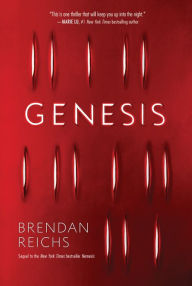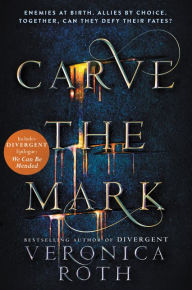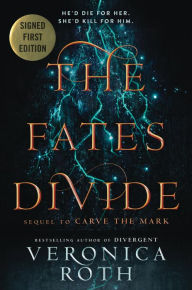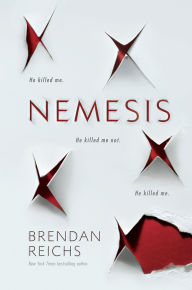Brendan Reichs and Veronica Roth Talk Genesis, Carve the Mark, and Sci-fi and Dystopian Worldbuilding
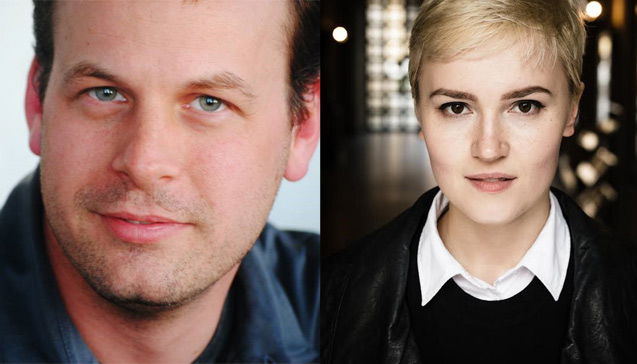 To celebrate the release of The Fates Divide, sequel to Veronica Roth‘s bestselling Carve the Mark, and Genesis, the latest in Brendan Reichs’ Project Nemesis series, the authors stopped by the blog to discuss building dystopian and science fictional worlds. We feel ready to write a ten-book space opera just having listened to them, but should probably relax with a cup of coffee and a few copies of their books first.
To celebrate the release of The Fates Divide, sequel to Veronica Roth‘s bestselling Carve the Mark, and Genesis, the latest in Brendan Reichs’ Project Nemesis series, the authors stopped by the blog to discuss building dystopian and science fictional worlds. We feel ready to write a ten-book space opera just having listened to them, but should probably relax with a cup of coffee and a few copies of their books first.
Genesis (Project Nemesis Series #2)
Genesis (Project Nemesis Series #2)
Hardcover $18.99
Brendan Reichs: Veronica! Awesome, awesome, awesome to chat with you. I admit to being slightly intimidated discussing sci-fi and dystopian worlds with a master, but here goes. Give me your secrets. I’ve always found this an interesting topic, because my previous worldbuilding has focused heavily on the “science” side of science fiction. I’ve never written about outer space, but I’ve used technology extensively, and I certainly like blowing things up. In my Project Nemesis series I tried to create a specific setting I hadn’t read much, but always found fascinating: the pre-apocalyptic world. In Nemesis, I explored what choices people might make if a devastating global calamity was on the way, but also…maybe not. What would you do in a world that might be destroyed, but also might be just fine? I didn’t really get down to gritty dystopian work until its sequel Genesis, my new book releasing today. But you’ve done both in expert fashion—the Divergent series for dystopia and Carve the Mark and The Fates Divide for more traditional sci-fi (I cannot wait until Fates comes out April 10—where is my copy?!). So what’s your take on the world-building hype? Do you prefer planetary devastation or the total vacuum of space?
Veronica Roth: Honestly, Brendan, you flatter me. It’s funny, though, because I’m equally intimidated in that I would find the imminent apocalypse really difficult to write about! Simply because—well, how do you know your world is heading for a cataclysmic event? Knowing things on a global scale—putting the pieces together and drawing the conclusion that everything is ending without coming across as a conspiracy nut—might be harder than we think. No one wants to believe their world is ending, after all.
Brendan Reichs: Veronica! Awesome, awesome, awesome to chat with you. I admit to being slightly intimidated discussing sci-fi and dystopian worlds with a master, but here goes. Give me your secrets. I’ve always found this an interesting topic, because my previous worldbuilding has focused heavily on the “science” side of science fiction. I’ve never written about outer space, but I’ve used technology extensively, and I certainly like blowing things up. In my Project Nemesis series I tried to create a specific setting I hadn’t read much, but always found fascinating: the pre-apocalyptic world. In Nemesis, I explored what choices people might make if a devastating global calamity was on the way, but also…maybe not. What would you do in a world that might be destroyed, but also might be just fine? I didn’t really get down to gritty dystopian work until its sequel Genesis, my new book releasing today. But you’ve done both in expert fashion—the Divergent series for dystopia and Carve the Mark and The Fates Divide for more traditional sci-fi (I cannot wait until Fates comes out April 10—where is my copy?!). So what’s your take on the world-building hype? Do you prefer planetary devastation or the total vacuum of space?
Veronica Roth: Honestly, Brendan, you flatter me. It’s funny, though, because I’m equally intimidated in that I would find the imminent apocalypse really difficult to write about! Simply because—well, how do you know your world is heading for a cataclysmic event? Knowing things on a global scale—putting the pieces together and drawing the conclusion that everything is ending without coming across as a conspiracy nut—might be harder than we think. No one wants to believe their world is ending, after all.
Carve the Mark (Carve the Mark Series #1)
Carve the Mark (Carve the Mark Series #1)
In Stock Online
Paperback $15.99
As for me, I preferred outer space to dystopia, simply because a well-built dystopia requires a high level of understanding of our world. You have to know how we got here to imagine where we might be going, and how fast, and what events might realistically happen to get us there. At 22, I felt equal to the task; at 29, I have a better understanding of how little I know. Carve the Mark and The Fates Divide have given me the opportunity to invent something completely new, a galaxy with its own history, planets with completely unfamiliar languages and cultures. The tricky part was actually that newness—making sure I wasn’t leaning on existing languages or cultures as a kind of shorthand. One of the solutions to that problem was to make it a place of diverse origins, so none of the cultures are homogenous-looking. Another was to dive into the world of conlang, or constructed languages, to make huge lists of sounds and syllables so I could invent names and words and place names. Basically it was a big, scary sandbox, and I loved playing in it.
So how did you take on the pre-apocalypse? Were there any books or movies or TV shows that you read/watched for “research”? Did you spend days reading about doomsday prep?
Reichs: I get shivers just thinking about the research you must have done on constructed languages. That sounds pretty intimidating, but also fascinating. Building a world from scratch is both an amazing freedom and a big responsibility, as you astutely pointed out. For me, I was inspired by The Last Policeman, by Ben Winters, which tells the story of a police officer investigating a suspicious death during the time period after an asteroid has been conclusively confirmed to be on a collision course with Earth (and likely to kill everyone). To me, the overarching stress—the “is everything I do totally pointless” feeling—was interesting to explore. I borrowed some of that while also leaving a door open. In Nemesis, it’s unclear whether a global calamity will happen. Either this threat will destroy everyone and everything, or nothing will come of it. And where I wanted to go was: what if the open threat wasn’t actually the most sinister thing going on? What if the facial problem was merely a symptom of something far worse? That’s what I try to develop in the Project Nemesis series. I just dive down rabbit hole after rabbit hole.
And you’re right, I spent a lot of time researching end-of-the-world scenarios and have developed a healthy fear of them all. This planet is very, very vulnerable to extinction level events if you’re thinking on a cosmic time-scale. It’s unnerving. But I also wanted to craft a good conspiracy. In Nemesis and Genesis, I isolate my characters in a very small setting and then manipulate it to put pressure on them. I wanted the place itself—the small vacation town of Fire Lake, Idaho—to have an active role in the story. So I think the micro-characteristics of my setting are every bit as important as the large scale world-building. Did you encounter that in Carve The Mark? How did you balance rolling out a grand vision while also being sure to highlight the small details that give a place depth and life?
As for me, I preferred outer space to dystopia, simply because a well-built dystopia requires a high level of understanding of our world. You have to know how we got here to imagine where we might be going, and how fast, and what events might realistically happen to get us there. At 22, I felt equal to the task; at 29, I have a better understanding of how little I know. Carve the Mark and The Fates Divide have given me the opportunity to invent something completely new, a galaxy with its own history, planets with completely unfamiliar languages and cultures. The tricky part was actually that newness—making sure I wasn’t leaning on existing languages or cultures as a kind of shorthand. One of the solutions to that problem was to make it a place of diverse origins, so none of the cultures are homogenous-looking. Another was to dive into the world of conlang, or constructed languages, to make huge lists of sounds and syllables so I could invent names and words and place names. Basically it was a big, scary sandbox, and I loved playing in it.
So how did you take on the pre-apocalypse? Were there any books or movies or TV shows that you read/watched for “research”? Did you spend days reading about doomsday prep?
Reichs: I get shivers just thinking about the research you must have done on constructed languages. That sounds pretty intimidating, but also fascinating. Building a world from scratch is both an amazing freedom and a big responsibility, as you astutely pointed out. For me, I was inspired by The Last Policeman, by Ben Winters, which tells the story of a police officer investigating a suspicious death during the time period after an asteroid has been conclusively confirmed to be on a collision course with Earth (and likely to kill everyone). To me, the overarching stress—the “is everything I do totally pointless” feeling—was interesting to explore. I borrowed some of that while also leaving a door open. In Nemesis, it’s unclear whether a global calamity will happen. Either this threat will destroy everyone and everything, or nothing will come of it. And where I wanted to go was: what if the open threat wasn’t actually the most sinister thing going on? What if the facial problem was merely a symptom of something far worse? That’s what I try to develop in the Project Nemesis series. I just dive down rabbit hole after rabbit hole.
And you’re right, I spent a lot of time researching end-of-the-world scenarios and have developed a healthy fear of them all. This planet is very, very vulnerable to extinction level events if you’re thinking on a cosmic time-scale. It’s unnerving. But I also wanted to craft a good conspiracy. In Nemesis and Genesis, I isolate my characters in a very small setting and then manipulate it to put pressure on them. I wanted the place itself—the small vacation town of Fire Lake, Idaho—to have an active role in the story. So I think the micro-characteristics of my setting are every bit as important as the large scale world-building. Did you encounter that in Carve The Mark? How did you balance rolling out a grand vision while also being sure to highlight the small details that give a place depth and life?
The Fates Divide (Signed Book) (Carve the Mark Series #2)
The Fates Divide (Signed Book) (Carve the Mark Series #2)
Hardcover $21.99
Roth: You sound alarmingly like a mad scientist experimenting on fake people, which oddly makes me even more excited to read Genesis. I mean, at its core, isn’t that what storytelling is? You make up a fake person, you give them a bunch of fake problems, and then you put them in a bad situation to see how they come out of it. Except for you, it seems like the problems are on a much greater scale. And the situation is in Idaho.
It’s funny you should ask about details, because that’s something I’ve been working on in my writing, particularly with Carve the Mark and The Fates Divide. My writing style is naturally quite sparse, which I think is more apparent in the Divergent books than in this series, and my tendency is not to describe things, or to do so in sweeping, vague terms. But that wasn’t what I wanted for Carve the Mark—I wanted a world that felt detailed and fully realized, like you were stepping into a place that had always existed, the way that some of my favorite science fiction and fantasy feels. I actually learned a lot from my husband. He’s not a writer, but he is extraordinarily observant and has an eye for detail. He points out the small things of the world to me, whether they’re beautiful or just odd or a little bit funny. So writing this series has been me trying to become a little more like that—pointing out this teapot, or that embroidery on a dress, or a character’s patchy facial hair, or in The Fates Divide, little rocks that are sensitive to the vibrations of sound, so they glow when a person whistles. Even though there are difficult things happening in the world around Cyra and Akos, I love spending time in their world, and I hope it’s that way for anyone who reads it, too.
One of the things I loved about Nemesis was seeing one of your main characters, Noah, come to terms with his profound anxiety as well as the truth about what had happened to him—a stark contrast to how unerringly Min believed in her own perceptions. I’m curious: how do those two develop further in Genesis? Will we get to know other characters better, too?
Roth: You sound alarmingly like a mad scientist experimenting on fake people, which oddly makes me even more excited to read Genesis. I mean, at its core, isn’t that what storytelling is? You make up a fake person, you give them a bunch of fake problems, and then you put them in a bad situation to see how they come out of it. Except for you, it seems like the problems are on a much greater scale. And the situation is in Idaho.
It’s funny you should ask about details, because that’s something I’ve been working on in my writing, particularly with Carve the Mark and The Fates Divide. My writing style is naturally quite sparse, which I think is more apparent in the Divergent books than in this series, and my tendency is not to describe things, or to do so in sweeping, vague terms. But that wasn’t what I wanted for Carve the Mark—I wanted a world that felt detailed and fully realized, like you were stepping into a place that had always existed, the way that some of my favorite science fiction and fantasy feels. I actually learned a lot from my husband. He’s not a writer, but he is extraordinarily observant and has an eye for detail. He points out the small things of the world to me, whether they’re beautiful or just odd or a little bit funny. So writing this series has been me trying to become a little more like that—pointing out this teapot, or that embroidery on a dress, or a character’s patchy facial hair, or in The Fates Divide, little rocks that are sensitive to the vibrations of sound, so they glow when a person whistles. Even though there are difficult things happening in the world around Cyra and Akos, I love spending time in their world, and I hope it’s that way for anyone who reads it, too.
One of the things I loved about Nemesis was seeing one of your main characters, Noah, come to terms with his profound anxiety as well as the truth about what had happened to him—a stark contrast to how unerringly Min believed in her own perceptions. I’m curious: how do those two develop further in Genesis? Will we get to know other characters better, too?
Nemesis (Project Nemesis Series #1)
Nemesis (Project Nemesis Series #1)
In Stock Online
Paperback $12.99
Reichs: I love what you’re saying about tiny details. I think they bring a setting alive to a much greater degree than telling the reader a list of objects in a room, or how cold it is, or things like that. (*Scans last setting description, realizes it is a detailed inventory of a house, hits delete.*) Coming from a legal background, I’ve employed a sparse writing style as well. I like the action to start at a fast clip and never stop, and my novels tend to reflect that. But I’ve been working on detail as well, trying to get more objective correlatives into my work (which can make certain people scream). I think using symbols to convey emotion can be powerful if done well, deepening theme and adding that elusive second layer of nuance to a description. But I’m still going to wreck things, mostly. Can’t change who you are.
I appreciate your take on Min and Noah, because that’s exactly what I was trying to do. I love STRONG FEMALE PROTAGONISTS—they’re the only type of viewpoint character I’ve ever written before Nemesis—but I think we both agree that term has become a little reductive, in that girls suddenly have to evince traditionally masculine traits or else they aren’t considered worthy role models. While Min certainly is strong, she’s also vulnerable and makes poor decisions, which is entirely normal. She cries, loses her temper, feels intimidated, and can be unfair when angry. None of this makes her any less “strong,” it just makes her more human. With Noah, I wanted to try something I haven’t read much—a male point-of-view character who is not strong. Or silent. Or brooding. Or even particularly admirable at times. Throughout much of Nemesis, Noah is simply a decent kid who’s barely holding it together in the face of terrible events. He understands he should follow Min’s instincts because they’re consistently better than his. But something happens to change him, and he begins Genesis in a much darker, more dangerous emotional place. Noah believes he is required to act in a certain way, despite it going against his natural inclinations. His struggle with that is central to the book. Min, however, remains grounded in her beliefs, but has to marry them to an environment where they seem not to apply. Their emotional arcs are as fundamental to the story as the plot.
I also pull quite a few of the background characters to the fore in Genesis, which was particularly fun. It’s wonderful to flesh out the cast and give it depth and variety. But enough about me. Regarding your smoldering characters, Cyra and Akos, what emotions are they predominantly dealing with in The Fates Divide? You left everyone in such precarious places that I have no idea how they’ll act going forward. I see trouble ahead. The best possible kind of trouble.
Roth: I’m so glad I have an early copy of Genesis waiting for me at home, because I love everything you’re saying. Give me all the pre-apocalyptic feels! I like when we allow teenage characters to be confused, because I don’t know about you, but I spent every year from thirteen to eighteen feeling completely bewildered by the world. (Actually, let’s be real, the world is more bewildering to me than ever before. But for different reasons this time.)
Reichs: I love what you’re saying about tiny details. I think they bring a setting alive to a much greater degree than telling the reader a list of objects in a room, or how cold it is, or things like that. (*Scans last setting description, realizes it is a detailed inventory of a house, hits delete.*) Coming from a legal background, I’ve employed a sparse writing style as well. I like the action to start at a fast clip and never stop, and my novels tend to reflect that. But I’ve been working on detail as well, trying to get more objective correlatives into my work (which can make certain people scream). I think using symbols to convey emotion can be powerful if done well, deepening theme and adding that elusive second layer of nuance to a description. But I’m still going to wreck things, mostly. Can’t change who you are.
I appreciate your take on Min and Noah, because that’s exactly what I was trying to do. I love STRONG FEMALE PROTAGONISTS—they’re the only type of viewpoint character I’ve ever written before Nemesis—but I think we both agree that term has become a little reductive, in that girls suddenly have to evince traditionally masculine traits or else they aren’t considered worthy role models. While Min certainly is strong, she’s also vulnerable and makes poor decisions, which is entirely normal. She cries, loses her temper, feels intimidated, and can be unfair when angry. None of this makes her any less “strong,” it just makes her more human. With Noah, I wanted to try something I haven’t read much—a male point-of-view character who is not strong. Or silent. Or brooding. Or even particularly admirable at times. Throughout much of Nemesis, Noah is simply a decent kid who’s barely holding it together in the face of terrible events. He understands he should follow Min’s instincts because they’re consistently better than his. But something happens to change him, and he begins Genesis in a much darker, more dangerous emotional place. Noah believes he is required to act in a certain way, despite it going against his natural inclinations. His struggle with that is central to the book. Min, however, remains grounded in her beliefs, but has to marry them to an environment where they seem not to apply. Their emotional arcs are as fundamental to the story as the plot.
I also pull quite a few of the background characters to the fore in Genesis, which was particularly fun. It’s wonderful to flesh out the cast and give it depth and variety. But enough about me. Regarding your smoldering characters, Cyra and Akos, what emotions are they predominantly dealing with in The Fates Divide? You left everyone in such precarious places that I have no idea how they’ll act going forward. I see trouble ahead. The best possible kind of trouble.
Roth: I’m so glad I have an early copy of Genesis waiting for me at home, because I love everything you’re saying. Give me all the pre-apocalyptic feels! I like when we allow teenage characters to be confused, because I don’t know about you, but I spent every year from thirteen to eighteen feeling completely bewildered by the world. (Actually, let’s be real, the world is more bewildering to me than ever before. But for different reasons this time.)
Divergent Series Four-Book Hardcover Gift Set: Divergent, Insurgent, Allegiant, Four
Divergent Series Four-Book Hardcover Gift Set: Divergent, Insurgent, Allegiant, Four
In Stock Online
Hardcover $81.96
As for Cyra and Akos, I don’t want to give too much away, but they’re on very different trajectories. By the end of Carve the Mark, Akos had given everything to rescue his brother from the dictator of Shotet, Ryzek Noavek. He hadn’t just risked his life, he’d taken other people’s lives, and that’s not something you just get over, particularly if you have the kind of gentle spirit that Akos does. So he’ll be dealing with the emotional aftermath of that, as well as the fear that what his brother has become is irreversible, and he may have done all those terrible things for no reason. Cyra, on the other hand, was raised to believe she was some kind of monster because of her painful and powerful abilities. She only started to question that at the end of Carve the Mark, when she chooses mercy for her brother instead of vengeance, and in The Fates Divide, she’ll be discovering more and more about who she really is. I definitely agree that “strong female protagonist” has become reductive, and even though Cyra, like Tris in Divergent, is a physically capable character (a stereotypically masculine trait for a hero), my goal is for her to be complicated. She’s not particularly nice; she’s not always confident; she struggles with self-loathing as a result of her upbringing. I identify with her in some of those ways—every one of us is a big mess sometimes, especially when we’re young and just figuring things out. So I love writing about her, and I hope she shows that you don’t have to have everything “together” in order for your story to be worth telling.
There’s plenty that’s threatening to come between Cyra and Akos, too—they’re on opposite sides of the war that’s brewing, coming from enemy cultures, for one thing. And for another, Akos’s fate still says that he will die for Cyra’s family one day, so there’s that feeling of dread to contend with. Neither of them have ever heard of a fate going unfulfilled, and like you said earlier, what do you do if you know the end is coming? Do you just…act like everything’s normal? Or do you have to change the way you make decisions? It’s all a complicated nightmare. And you know how much I love a complicated nightmare.
Reichs: I’ll be staring at my mailbox for a copy The Fates Divide every day after school. I’m excited to see it in the wild. Thanks so much for chatting with me about and talking shop. I be massive smarter now.
Roth: We both be. Cheers!
Genesis is out today! Find tour and appearance information at brendanreichs.com. The Fates Divide hits shelves April 10. Tour and appearance information can be found at veronicarothbooks.com.
As for Cyra and Akos, I don’t want to give too much away, but they’re on very different trajectories. By the end of Carve the Mark, Akos had given everything to rescue his brother from the dictator of Shotet, Ryzek Noavek. He hadn’t just risked his life, he’d taken other people’s lives, and that’s not something you just get over, particularly if you have the kind of gentle spirit that Akos does. So he’ll be dealing with the emotional aftermath of that, as well as the fear that what his brother has become is irreversible, and he may have done all those terrible things for no reason. Cyra, on the other hand, was raised to believe she was some kind of monster because of her painful and powerful abilities. She only started to question that at the end of Carve the Mark, when she chooses mercy for her brother instead of vengeance, and in The Fates Divide, she’ll be discovering more and more about who she really is. I definitely agree that “strong female protagonist” has become reductive, and even though Cyra, like Tris in Divergent, is a physically capable character (a stereotypically masculine trait for a hero), my goal is for her to be complicated. She’s not particularly nice; she’s not always confident; she struggles with self-loathing as a result of her upbringing. I identify with her in some of those ways—every one of us is a big mess sometimes, especially when we’re young and just figuring things out. So I love writing about her, and I hope she shows that you don’t have to have everything “together” in order for your story to be worth telling.
There’s plenty that’s threatening to come between Cyra and Akos, too—they’re on opposite sides of the war that’s brewing, coming from enemy cultures, for one thing. And for another, Akos’s fate still says that he will die for Cyra’s family one day, so there’s that feeling of dread to contend with. Neither of them have ever heard of a fate going unfulfilled, and like you said earlier, what do you do if you know the end is coming? Do you just…act like everything’s normal? Or do you have to change the way you make decisions? It’s all a complicated nightmare. And you know how much I love a complicated nightmare.
Reichs: I’ll be staring at my mailbox for a copy The Fates Divide every day after school. I’m excited to see it in the wild. Thanks so much for chatting with me about and talking shop. I be massive smarter now.
Roth: We both be. Cheers!
Genesis is out today! Find tour and appearance information at brendanreichs.com. The Fates Divide hits shelves April 10. Tour and appearance information can be found at veronicarothbooks.com.
